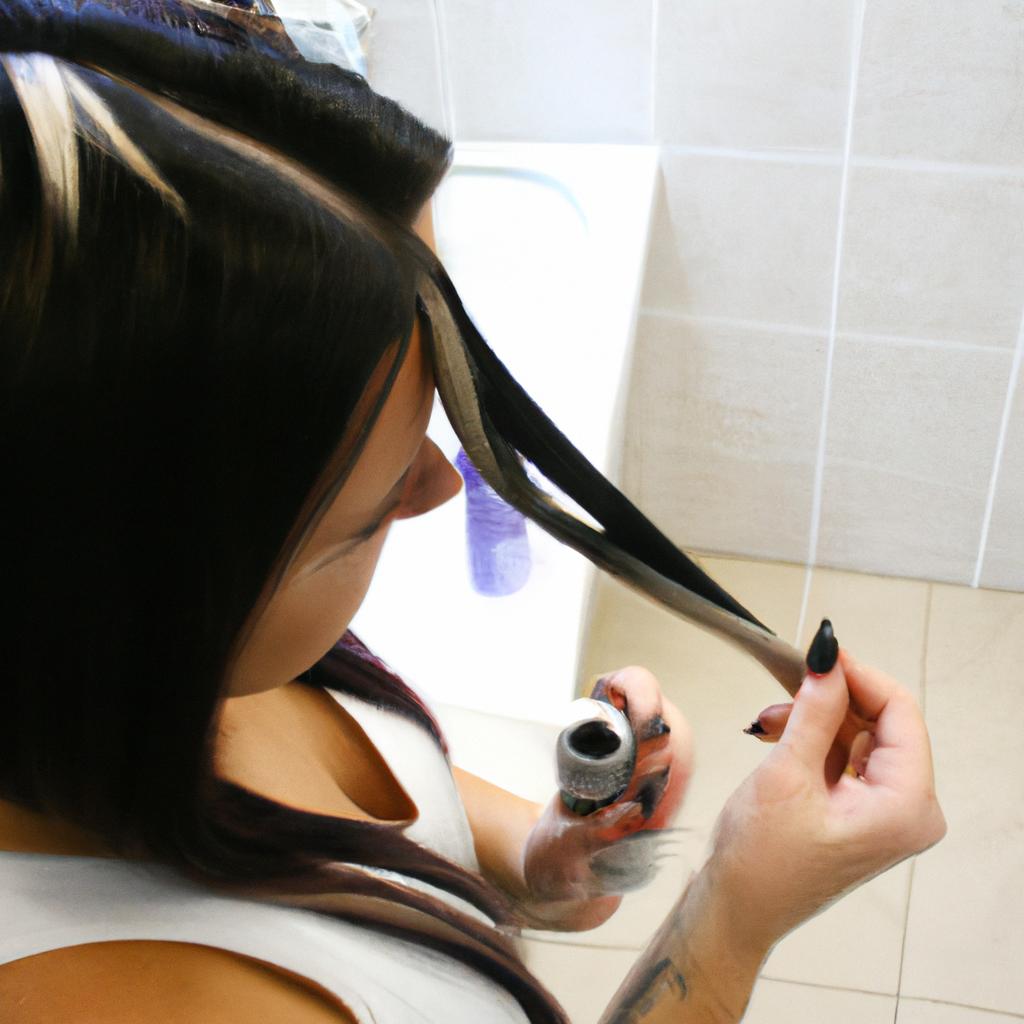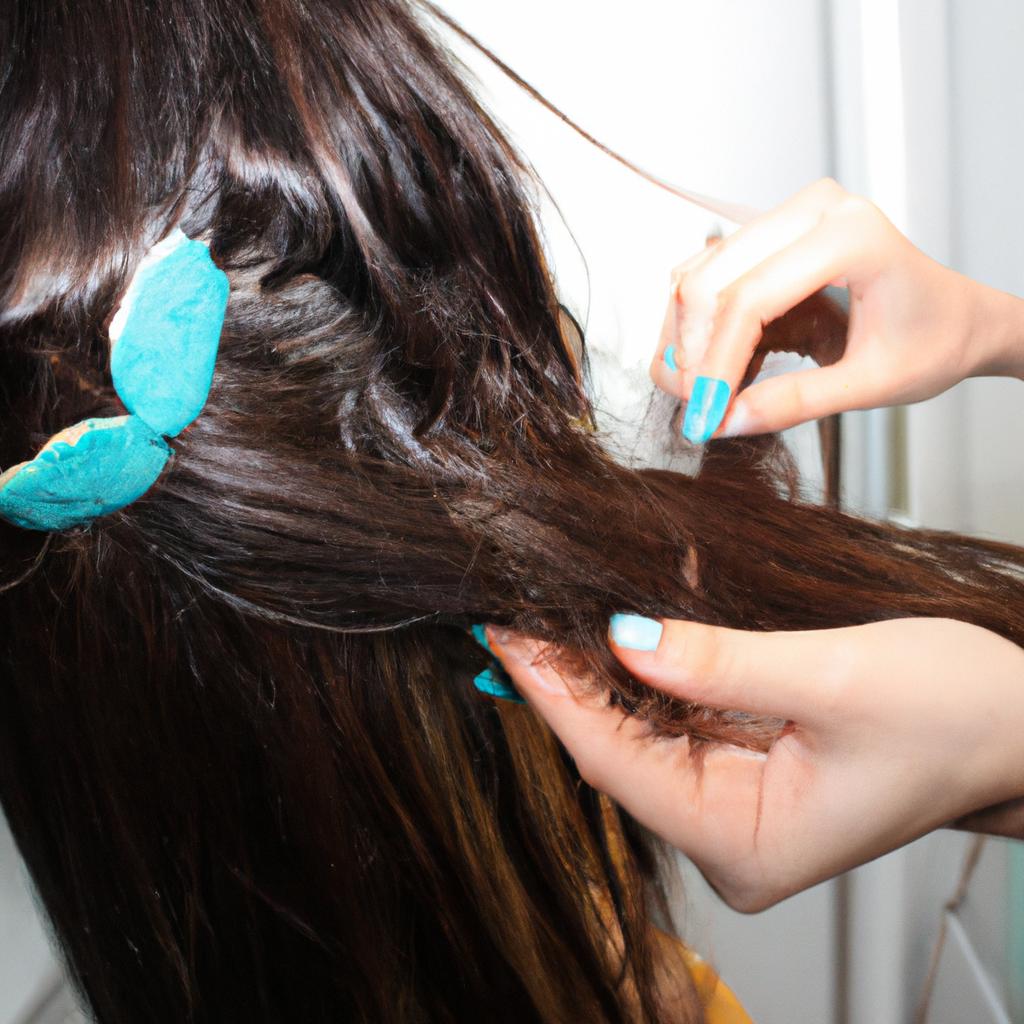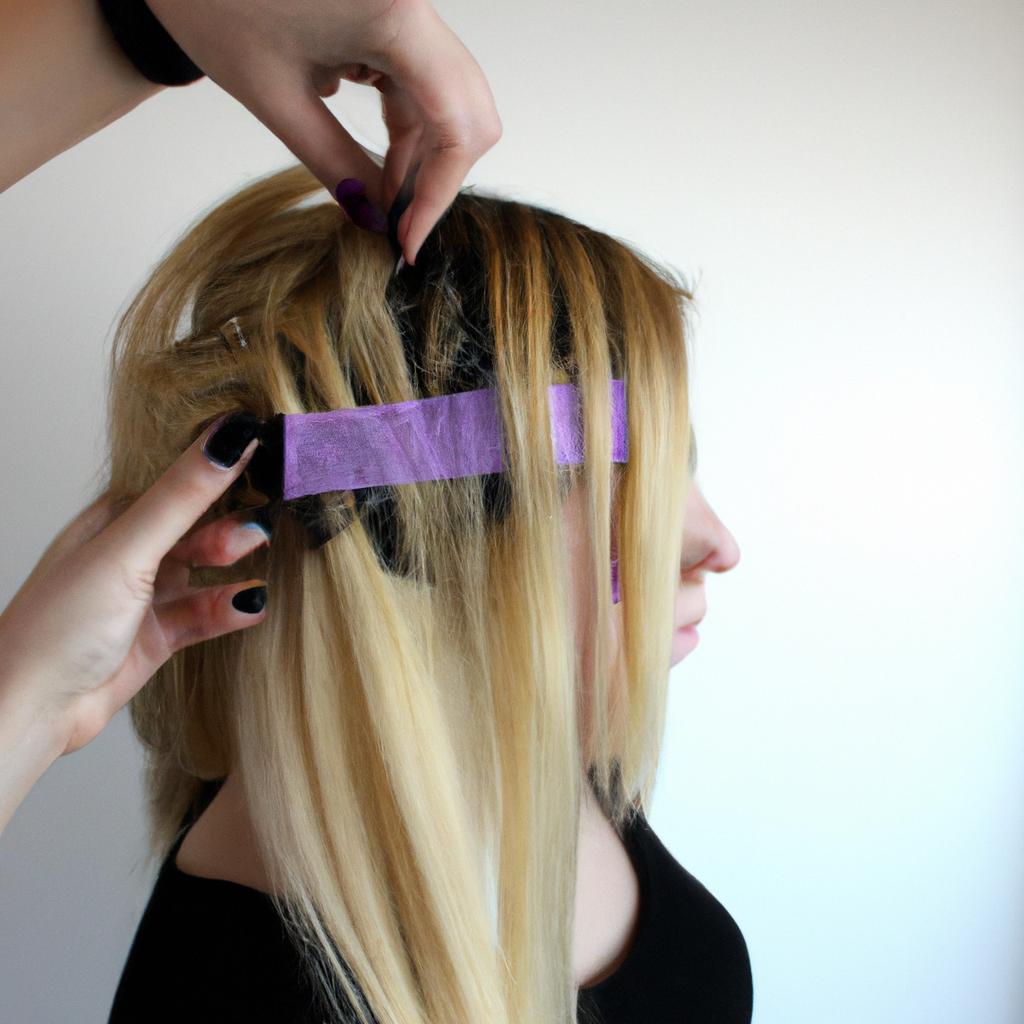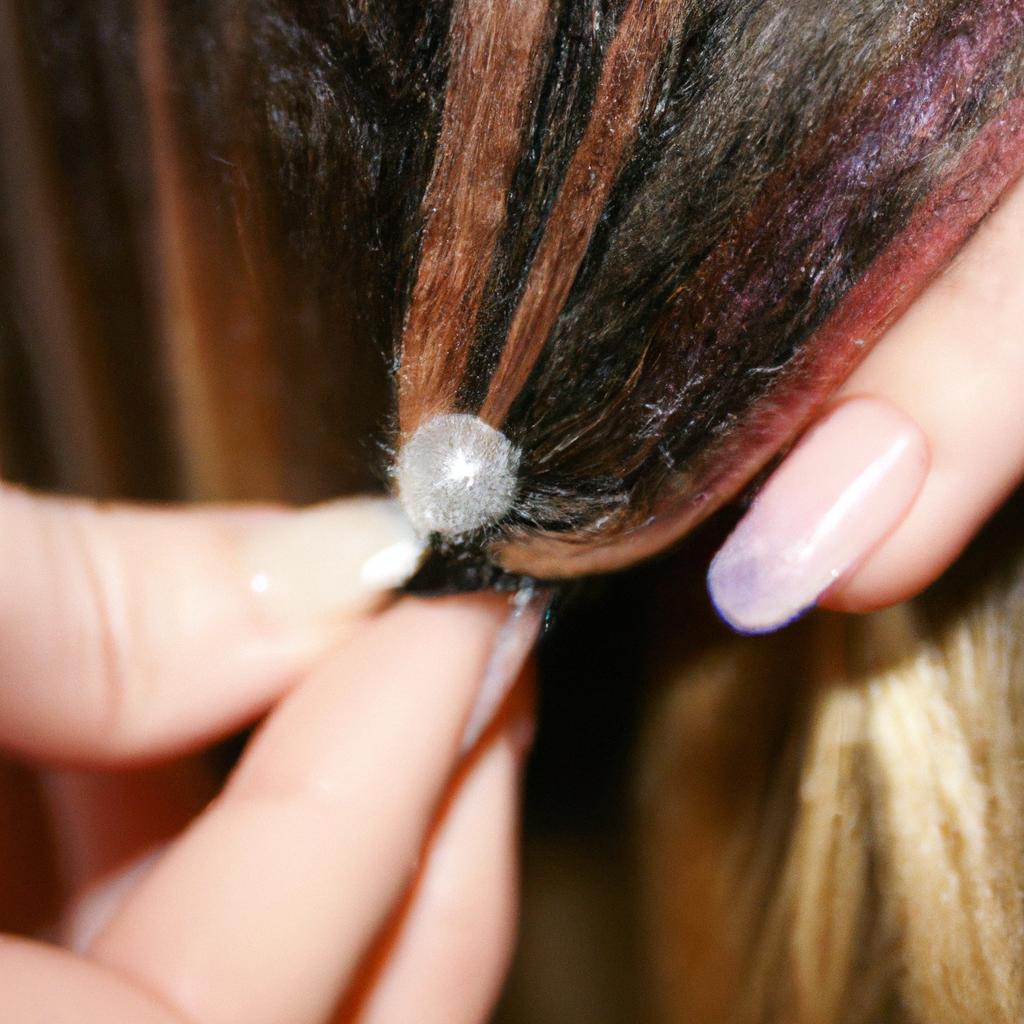Fusion extensions, a popular hairdressing technique that seamlessly blends natural and artificial hair strands, have garnered significant attention in the beauty industry. This article aims to provide insights into fusion extensions from the perspective of hairdressing salons. By examining both the benefits and challenges associated with this technique, salon professionals can gain valuable knowledge to better serve their clients.
To illustrate the impact of fusion extensions, consider the case study of a client named Sarah. Sarah had always desired long and voluminous hair but struggled with her thin and fine locks. After consulting with a skilled stylist at a reputable salon, she opted for fusion extensions as a solution. The transformation was remarkable; Sarah’s new hairstyle not only enhanced her appearance but also boosted her confidence. This example underscores how fusion extensions can offer individuals an opportunity to achieve their desired look while addressing specific concerns related to their natural hair texture.
While fusion extensions undoubtedly present numerous advantages, they are not without challenges. Hairdressers need to possess extensive expertise in order to perform successful application techniques and ensure seamless integration between natural and artificial strands. Additionally, proper maintenance is crucial to prevent potential damage or discomfort caused by tangles or breakage at the attachment points. Understanding these intricacies will enable hairdressing salons to navigate navigate the complexities of fusion extensions and provide a high-quality service to their clients.
One of the key benefits of fusion extensions is their ability to create a natural-looking hairstyle. The strands of artificial hair are carefully blended with the client’s natural hair, resulting in a seamless integration that is virtually undetectable. This allows individuals to enjoy long, voluminous locks without sacrificing authenticity or compromising on style.
Furthermore, fusion extensions offer versatility in terms of styling options. Clients can experiment with different hairstyles, such as braids, updos, or even heat-styling techniques like curling or straightening. This flexibility allows individuals to switch up their look whenever desired, adding variety and excitement to their everyday appearance.
However, it is important for salon professionals to be aware of the challenges associated with fusion extensions. Firstly, the application process requires skill and precision. Hairdressers must be well-trained in the specific techniques involved to ensure that each strand is attached securely and accurately. This not only guarantees a natural-looking outcome but also minimizes any discomfort or potential damage to the client’s natural hair.
Maintenance is another crucial aspect that should not be overlooked. Regular care and upkeep are essential for maintaining the longevity and health of fusion extensions. Clients need to be educated about proper cleansing routines, avoiding excessive heat exposure, and using appropriate products specifically designed for extension maintenance. By providing comprehensive aftercare instructions, salons can help clients prolong the lifespan of their fusion extensions while preserving the integrity of their natural hair.
In conclusion, fusion extensions offer a transformative solution for individuals seeking longer and fuller hair. Salons that understand both the benefits and challenges associated with this technique will be better equipped to meet their clients’ needs effectively. With expert application techniques and diligent maintenance practices, hairstylists can provide exceptional services that enhance both the appearance and confidence of their clients.
Understanding Fusion Hair Extensions
Fusion hair extensions have become increasingly popular in the field of hairdressing, providing individuals with a way to enhance their natural locks and achieve desired hairstyles. One example that highlights the transformative power of fusion extensions is Lisa, a thirty-year-old woman who had always struggled with thin and lifeless hair. After getting fusion extensions, her hair became fuller and more voluminous, boosting her confidence and allowing her to experiment with different styles.
To better understand fusion hair extensions, it is important to explore how they are applied. Fusion extensions involve attaching individual strands of human or synthetic hair to small sections of the client’s natural hair using a keratin-based adhesive. This method ensures a seamless blend between the extension and the natural hair, creating a natural-looking result that can last for several months with proper maintenance.
When considering whether fusion extensions are suitable for you, there are several factors to take into account:
- Cost: Fusion extensions tend to be more expensive compared to other types due to the time-consuming application process.
- Maintenance: Proper care is crucial for maintaining fusion extensions. Regular brushing, avoiding excessive heat styling, and using recommended products are necessary for longevity.
- Lifestyle: Individuals with active lifestyles may need to consider potential limitations associated with fusion extensions, such as restrictions on certain activities like swimming or intense workouts.
- Commitment: Fusion extensions require regular maintenance appointments every few weeks to ensure they remain securely attached until it is time for removal or reapplication.
Table: Pros and Cons of Fusion Hair Extensions
| Pros | Cons |
|---|---|
| Natural-looking results | Higher cost |
| Longevity | Time-consuming application process |
| Versatile styling options | Maintenance requirements |
| Boosts self-confidence | Potential lifestyle limitations |
In summary, understanding fusion hair extensions involves recognizing both their benefits and considerations. With proper application and care, these extensions offer individuals the opportunity to achieve natural-looking, voluminous hair. However, it is essential to consider factors such as cost, maintenance requirements, lifestyle limitations, and commitment before deciding on this particular extension method.
Transitioning into the subsequent section about “Different Types of Fusion Extensions,” let’s explore the various options available for those seeking fusion extensions.
Different Types of Fusion Extensions
Building on the foundation of understanding fusion hair extensions, let us delve into the different types available in salons. To illustrate, consider a hypothetical scenario where a client named Sarah walks into a hairdressing salon seeking to add length and volume to her thinning hair.
-
Keratin Bonded Extensions:
- These extensions use keratin protein bonds that are melted onto individual strands of natural hair.
- The bonds create a seamless blend between the extension and the natural hair, providing a natural-looking result.
- They can last for up to six months with proper care and maintenance.
- However, they require heat during installation, which can potentially damage the natural hair if not done correctly.
-
Micro Link (or Beaded) Extensions:
- This type involves small metal rings or beads that are clamped onto sections of natural hair using special tools.
- The extensions are then attached to these rings or beads, securing them in place.
- Micro link extensions offer versatility as they can be easily adjusted and moved without damaging the natural hair.
- However, improper placement or excessive tension on the links can cause discomfort and breakage.
-
Tape-In Extensions:
- As the name suggests, tape-in extensions involve applying wefts of hair using double-sided adhesive tape.
- These extensions lie flat against the scalp and provide an undetectable appearance when properly installed.
- They can be reused multiple times by replacing the tape after removal.
- However, tape-in extensions may require more frequent maintenance appointments compared to other methods.
-
Weave (or Sew-In) Extensions:
Pros Cons Natural look and feel Requires professional expertise Provides long-lasting results May put strain on natural hair Allows for versatile styling options Longer installation time compared to others Suitable for various hair textures Regular maintenance is necessary
It is important to note that the choice of fusion extension type ultimately depends on factors such as personal preference, hair condition, and desired results. Each method has its own unique advantages and considerations.
Understanding the different types of fusion extensions sets the stage for a comprehensive evaluation of their pros and cons.
Pros and Cons of Fusion Hair Extensions
Transition from Previous Section H2:
Having explored the different types of fusion extensions, let us now delve into the pros and cons associated with these popular hair extensions. To illustrate their impact, consider the case study of Lisa, a young professional seeking to add length and volume to her shoulder-length hair for an upcoming event.
Pros and Cons of Fusion Hair Extensions
For Lisa, fusion hair extensions offered several advantages. Firstly, they provided natural-looking results that seamlessly blended with her existing hair. The individual strands were meticulously bonded to small sections of her own hair using keratin or protein-based adhesives, ensuring a discreet integration. Secondly, the durability of fusion extensions allowed Lisa to enjoy long-lasting results without worrying about regular maintenance or reapplication. This was particularly beneficial as she wanted her new hairstyle to last throughout the duration of her event.
However, it is important to acknowledge that there are certain drawbacks associated with fusion hair extensions as well. One concern is the potential damage caused during the removal process. While proper removal techniques minimize risks, improper removal or excessive force can lead to breakage or weakening of the natural hair strands. Additionally, due to their intricate application method, fusion extensions tend to be more time-consuming and costly compared to other types of extensions. This could pose challenges for individuals who have limited budgets or time constraints.
To further understand the intricacies involved in choosing fusion extensions as a desired hairstyling option, let us examine a brief comparison between fusion extensions and other commonly used methods:
| Hair Extension Method | Benefits | Drawbacks |
|---|---|---|
| Fusion Extensions | Natural appearance | Time-consuming |
| Long-lasting | Potentially damaging | |
| Tape-in Extensions | Quick application | Visible tabs |
| Affordable | Regular adjustments | |
| Clip-in Extensions | Temporary use | Limited styling options |
| Easy application | Daily removal |
By analyzing these different hair extension methods, it becomes evident that each option has its own unique set of advantages and disadvantages. The decision ultimately depends on an individual’s personal preferences, lifestyle, and desired results.
By understanding the preparation process, you can ensure optimal outcomes and minimize any potential complications or issues during the application phase.
Preparing Your Hair for Fusion Extensions
Transition from previous section:
Having discussed the pros and cons of fusion hair extensions, it is now crucial to explore the necessary steps involved in preparing your hair for this type of extension. In order to achieve optimal results and ensure the longevity of your extensions, proper preparation is essential.
Preparing Your Hair for Fusion Extensions
To illustrate the importance of hair preparation, consider a hypothetical scenario where a client named Sarah visits a reputable salon to get fusion extensions. Sarah has long, fine hair that lacks volume and desires thicker and more luxurious locks. The stylist examines her natural hair and determines that specific preparations are required before commencing with the fusion extension application.
Prior to applying fusion extensions, several key steps must be taken:
- Hair Evaluation: A thorough assessment of your natural hair condition will be conducted by an experienced stylist. This evaluation helps determine if your current hair health is suitable for receiving fusion extensions.
- Trimming: Trimming any split ends or damaged strands ensures that your existing hair remains healthy throughout the process.
- Deep Conditioning Treatment: Nourishing your hair with a deep conditioning treatment restores moisture and strengthens its overall integrity.
- Scalp Exfoliation: Gentle exfoliation of the scalp eliminates buildup and promotes a healthier environment for both your natural hair and new extensions.
These preparatory measures pave the way for successful fusion extension application while minimizing potential damage or adverse effects on your natural tresses.
| Preparatory Steps | Benefits |
|---|---|
| Hair Evaluation | Ensures suitability for fusion extensions |
| Trimming | Maintains overall health of existing hair |
| Deep Conditioning | Restores moisture and enhances strength |
| Scalp Exfoliation | Promotes healthier environment for new growth |
By adhering to these practices, you can create an optimal foundation upon which to build stunning fusion extensions that seamlessly blend with your natural hair. Remember, the importance of preparing your hair cannot be overstated, as it significantly influences the final outcome.
Transitioning smoothly to the subsequent section about the “Fusion Extension Application Process,” let us now delve into the step-by-step procedure for applying fusion extensions and achieving a flawless result.
Fusion Extension Application Process
Transition from previous section:
Having adequately prepared your hair for fusion extensions, it is now time to delve into the application process. This section will guide you through the steps involved in achieving flawless and long-lasting fusion extensions.
Fusion Extension Application Process
To illustrate the intricacies of this procedure, let’s consider a hypothetical case study involving Sarah, who has fine, shoulder-length hair. Sarah desires voluminous and luscious locks that blend seamlessly with her natural hair. The following paragraphs outline the key steps involved in applying fusion extensions:
-
Sectioning: Before beginning the application process, Sarah’s stylist skillfully sections her hair into manageable portions using precise partings. This allows for a systematic approach during installation and ensures each extension strand is attached securely.
-
Bond Preparation: Next, the stylist carefully prepares the keratin bonds that will be used to attach the individual strands of hair. These bonds are usually made from high-quality materials and are available in various colors to match different shades of hair.
-
Strand Placement: With meticulous attention to detail, the stylist attaches each pre-tipped extension strand to Sarah’s natural hair near its root using heat or ultrasound technology. This method provides a secure bond while maintaining comfort for Sarah throughout the process.
-
Blending and Styling: Once all the desired extension strands have been applied, blending becomes crucial to achieve a seamless look. The stylist expertly trims and shapes both Sarah’s natural hair and the extensions until they harmoniously merge together. Lastly, styling techniques such as curling or straightening can be employed according to personal preference.
Let us now take a moment to evoke an emotional response by considering some important aspects related to fusion extensions:
- Markdown Bullet Point List:
- Boosts self-confidence by enhancing volume and length.
- Allows for versatile hairstyling options.
- Provides an opportunity for creative expression.
- Offers a temporary change without long-term commitment.
Furthermore, the table below highlights some of the benefits and considerations associated with fusion extensions:
| Benefits | Considerations |
|---|---|
| Natural-looking results | Longer application time |
| Long-lasting durability | Requires professional maintenance |
| Ability to customize length and volume | Higher initial cost |
| Suitable for various hair types and styles | Potential damage if not properly cared for |
As you can see, the fusion extension application process involves careful attention to detail, resulting in beautifully blended and customized hair. Now that we have covered the installation aspect, let’s move on to exploring maintenance and care tips for ensuring the longevity of your fusion hair extensions.
Maintenance and Care Tips for Fusion Hair Extensions
Transitioning from the application process, let us now delve into the essential maintenance and care tips for fusion hair extensions. To illustrate their significance, consider the case of Sarah, a client who recently had fusion extensions applied at our salon. Despite being thrilled with her new look initially, she soon encountered challenges due to inadequate maintenance. By following these guidelines, you can avoid similar issues and ensure your fusion extensions stay beautiful and healthy.
Maintenance and Care Tips for Fusion Hair Extensions:
-
Gentle Brushing: Use a wide-toothed comb or a soft-bristle brush specifically designed for hair extensions to gently detangle your hair. Start brushing from the ends and gradually work your way up towards the roots to prevent unnecessary tension on the bonds.
-
Regular Washing: Wash your hair no more than two to three times per week using sulfate-free shampoos and conditioners formulated for extension wearers. Avoid applying excessive pressure on the bonds while shampooing or drying your hair; instead, focus on massaging the scalp in between rows.
-
Heat Styling Precautions: While it’s possible to style your fusion extensions with heat tools, it is crucial to take precautions to protect both your natural hair and the bond area. Always use a heat protectant spray before styling, keep the temperature below 350°F (175°C), and avoid direct contact of hot tools with the bonds.
-
Regular Maintenance Appointments: Schedule regular visits to your hairstylist for maintenance checks and adjustments as needed. This ensures that any loose or damaged bonds are addressed promptly, preventing further damage or tangling.
Implementing these practices will help extend the lifespan of your fusion extensions while maintaining their flawless appearance. Remember that proper care is essential in preserving not only the integrity of your extensions but also ensuring optimal health for your natural hair.
| Benefits of Proper Fusion Extension Care |
|---|
| – Increased longevity of extensions |
| – Reduced risk of damage to natural hair |
| – Enhanced overall appearance and texture |
| – Boosted confidence and self-esteem |
By adhering to the maintenance tips outlined above, you can enjoy a seamless blend between your natural hair and fusion extensions, creating a glamorous and hassle-free style. Take pride in your investment by prioritizing regular care routines that will keep your extensions looking stunning for an extended period.
Incorporating these simple practices into your daily routine can make all the difference in maintaining the health and longevity of your fusion extensions. Embrace them as part of your personal hair care regimen, allowing yourself to confidently flaunt beautiful, voluminous locks every day.




